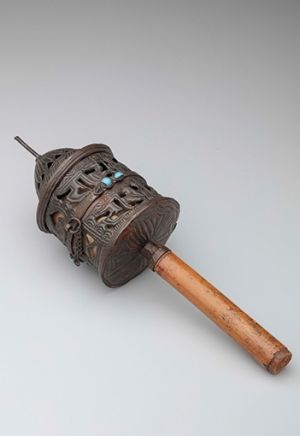Pierced Hand-held Prayer Wheel (mani lag 'khor)
The Tibetan prayer wheel contains positive intentions in the form of mantras, and relies on the power of touch to activate these intentions. A prayer wheel only has an effect when someone consciously activates the mantras and prayers contained within by spinning the wheel and setting it in motion.
Physical force ensures that prayer wheels function as aids in individual daily practices to advance personal and collective betterment. Unlike some devotional practices in Tibetan Buddhism that require high levels of skill and discipline, turning a prayer wheel does not require extraordinary abilities and thus can provide a tangible support to practice for many people. The repetition of physical movement is a useful aid to meditation, returning the mind again and again to the intentions activated through touch.
There are many kinds of prayer wheels, and this is a specific kind of hand wheel (lakkor), so called because it is held in one’s hand as it is turned. Many have remarked on the mechanical inventiveness of the prayer wheel, which uses a ball and chain counterweight to convert simple movements of the hand into the continuous motion of the wheel and mantras inside.
One historian even speculated that the weighted chain, known as the governor, may have inspired Western mechanical devices, via Italian traders. But despite the mechanical apparatus, only human touch, and the intention that drives it, can activate the hand wheel.
Monks and lay practitioners spin these wheels while circumambulating or worshipping at temples, or simply going about their daily lives. As they perform the simple recurring action of turning a prayer wheel with an intention in mind, each clockwise rotation is thought to “recite” the mantra om mani padme hum to generate compassion for all.
The artisans who handcrafted this prayer wheel employed their own power of touch. The hand wheel consists of a bamboo handle attached to a copper cylinder with a pointed dome at the top. The incised and cut-out designs on the cylinder include Sanskrit characters, crossed vajras, and blue glass stones.
A steel counterweight is attached with a chain as a governor. The cutouts enable the viewer to see a rim of the written mantras inside, which release prayers when the wheel is swung around by hand. The prayers cannot be seen because they are facing inward. The writing of the mantras on these scrolls of paper begins in the very center, so that it unfurls as if you were reading it.
Come view our Art of the Week, on loan from the Newark Museum in the Exhibition “Power of Intention: Reinventing the Prayer Wheel”
Source
[[1]]
